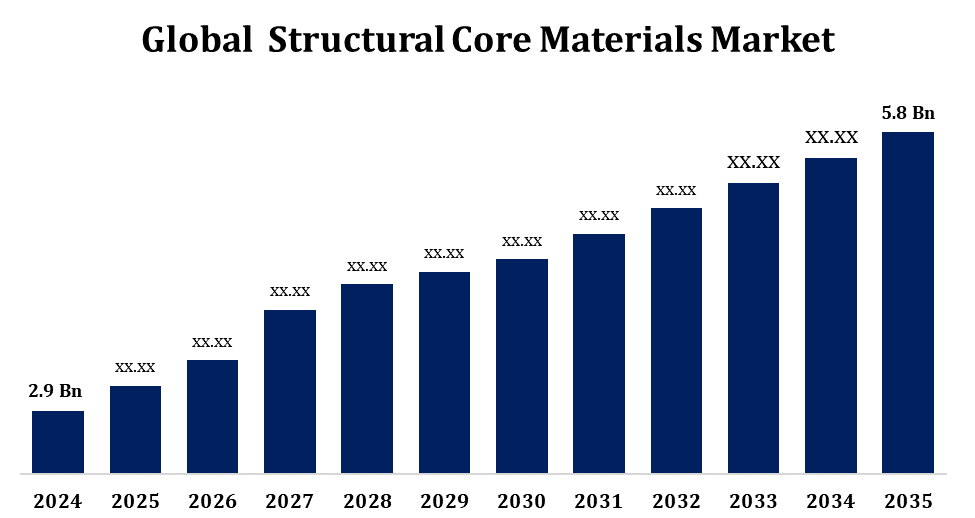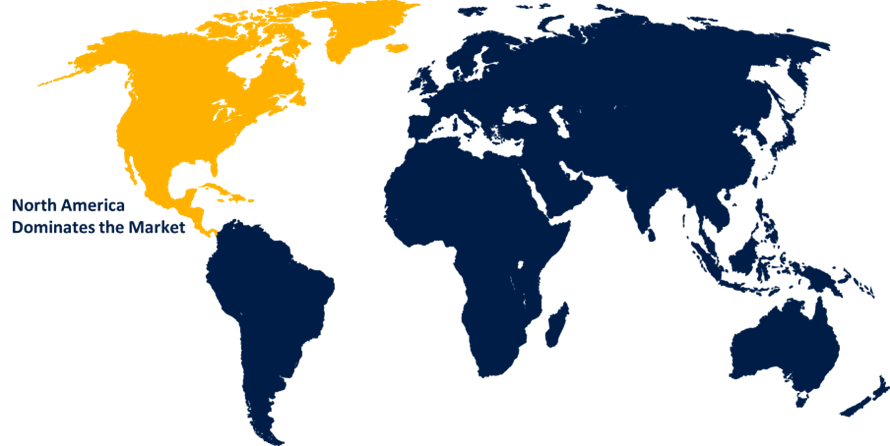Global Structural Core Materials Market Size, Share, and COVID-19 Impact Analysis, By Product (Honeycomb, Foam, Balsa), By Skin (GFRP, CFRP, NFRP), By End-use (Aerospace, Automotive, Wind Energy), and By Region (North America, Europe, Asia-Pacific, Latin America, Middle East, and Africa), Analysis and Forecast 2025 - 2035
Industry: Chemicals & MaterialsGlobal Structural Core Materials Market Insights Forecasts to 2035
- The Structural Core Materials Market was valued at USD 2.9 Billion in 2024.
- The Market is growing at a CAGR of 7.18% from 2025 to 2035.
- The Global Structural Core Materials Market is Expected to Reach USD 5.8 Billion by 2035.
- Asia Pacific is Expected to grow the fastest during the forecast period.

Get more details on this report -
The Global Structural Core Materials Market is Expected to Reach USD 5.8 Billion by 2035, at a CAGR of 7.18% during the forecast period 2025 to 2035.
The structural core materials market is growing due to increasing demand for lightweight, high-strength materials in industries such as aerospace, marine, wind energy, and automotive. These materials, including foam, balsa, and honeycomb cores, are valued for their ability to enhance strength-to-weight ratios, improve fuel efficiency, and support sustainability goals. Advancements in composite manufacturing and rising adoption in modern aircraft and electric vehicles are key drivers. The marine sector benefits from their resistance to water absorption and durability, while wind energy applications gain from improved blade performance. Asia Pacific is emerging as a significant market, supported by rapid industrial growth and infrastructure expansion. Ongoing research is fostering innovations in recyclable and bio-based cores, aligning with environmental and regulatory requirements.
Structural Core Materials Market Value Chain Analysis
The structural core materials market value chain begins with raw material suppliers providing polymers, natural fibers, resins, and metals used in core production. Manufacturers then process these into foam, balsa, or honeycomb cores through specialized fabrication techniques. Composite producers integrate these cores with skins or laminates to create lightweight, high-strength sandwich structures. Distributors and suppliers ensure timely delivery to end-use sectors such as aerospace, marine, wind energy, automotive, and construction. Design and engineering firms contribute by customizing core configurations for specific performance needs. End users rely on these solutions for improved strength-to-weight ratios, fuel efficiency, and durability. Continuous collaboration among stakeholders drives innovation in recyclable and bio-based materials, enhancing product sustainability and aligning with evolving industry and regulatory demands.
Structural Core Materials Market Opportunity Analysis
The structural core materials market offers significant opportunities driven by the push for lightweight, high-performance solutions across aerospace, marine, automotive, and wind energy sectors. Growing adoption of electric vehicles and the expansion of renewable energy projects create strong demand for cores that improve efficiency and durability. Advancements in manufacturing, including automation and additive processes, enable cost-effective, high-quality production. Emerging markets in Asia Pacific and Latin America present growth potential due to infrastructure development and industrialization. Opportunities also lie in developing recyclable, bio-based, and fire-resistant cores to meet stringent environmental and safety regulations. Customization for specific applications, such as next-generation aircraft or larger wind turbine blades, further expands market scope while encouraging long-term partnerships between manufacturers and end users.
Global Structural Core Materials Market Report Coverage
| Report Coverage | Details |
|---|---|
| Base Year: | 2024 |
| Market Size in 2024: | USD 2.9 billion |
| Forecast Period: | 2025-2035 |
| Forecast Period CAGR 2025-2035 : | 7.18% |
| 2035 Value Projection: | USD 5.8 Billion |
| Historical Data for: | 2020-2023 |
| No. of Pages: | 225 |
| Tables, Charts & Figures: | 119 |
| Segments covered: | By Product Analysis, By Skin Analysis, By End Use Analysis |
| Companies covered:: | Plascore Incorporated, Changzhou Tiansheng New Materials Co. Ltd., The Gill Corporation, Euro Composites, Armacell International, Hexcel Corporation, Diab Group, Gurit Holding, Schweiter Technologies, Evonik Industries |
| Growth Drivers: | A rising demand within the automotive sector |
| Pitfalls & Challenges: | COVID-19 Empact, Challenges, Future, Growth, & Analysis |
Get more details on this report -
Market Dynamics
Structural Core Materials Market Dynamics
Growing construction and infrastructure projects to boost market growth
The structural core materials market is set to benefit from the rapid expansion of construction and infrastructure projects worldwide. Increasing urbanization, population growth, and rising investment in modern infrastructure are driving demand for materials that offer high strength, durability, and lightweight properties. Structural cores, such as foam, balsa, and honeycomb, are increasingly used in architectural panels, bridges, and building facades due to their ability to enhance structural performance while reducing overall weight. Emerging economies are investing heavily in transportation networks, commercial buildings, and smart city developments, further fueling market growth. Additionally, the growing emphasis on sustainable construction practices is creating opportunities for eco-friendly and recyclable core materials, aligning with regulatory requirements and industry trends toward energy-efficient and environmentally responsible solutions.
Restraints & Challenges
High manufacturing and raw material costs, especially for advanced cores like aerospace-grade honeycomb, can limit adoption in cost-sensitive industries. Fluctuating prices of resins, metals, and natural resources such as balsa wood add supply chain volatility. The complex fabrication processes for high-performance cores require skilled labor and advanced machinery, increasing production expenses. Recycling and disposal of composite cores remain difficult, posing environmental concerns and compliance challenges. Additionally, strict regulatory standards in sectors such as aerospace and automotive demand extensive testing and certification, which can delay product launches. Competition from alternative lightweight materials and the need for continuous innovation to meet evolving performance requirements further intensify market pressures.
Regional Forecasts
North America Market Statistics

Get more details on this report -
North America is anticipated to dominate the Structural Core Materials Market from 2025 to 2035. The structural core materials market in North America is driven by strong demand from aerospace, marine, wind energy, and automotive industries. The region benefits from advanced manufacturing capabilities, a well-established supply chain, and significant investments in research and development. The United States leads the market, supported by its large aerospace sector, growing electric vehicle production, and offshore wind energy projects. Canada contributes through marine and construction applications, while both countries emphasize sustainable materials and compliance with stringent environmental regulations. Technological advancements in composite fabrication, coupled with government support for renewable energy and infrastructure modernization, are fueling market growth. Additionally, collaborations between manufacturers and research institutions are accelerating the development of innovative, recyclable, and high-performance core materials tailored to diverse industry needs.
Asia Pacific Market Statistics
Asia Pacific is witnessing the fastest market growth between 2025 to 2035. The structural core materials market in Asia Pacific is experiencing rapid growth, driven by expanding aerospace, marine, automotive, wind energy, and construction industries. Countries such as China, Japan, India, and South Korea are leading adoption, supported by industrialization, infrastructure development, and increasing renewable energy investments. China dominates the regional market with its large manufacturing base, rising aircraft production, and extensive wind turbine installations. Japan and South Korea contribute through advanced marine and automotive applications, while India’s growing infrastructure and electric vehicle sector present emerging opportunities. The region’s focus on lightweight, durable, and cost-effective materials aligns with efficiency and sustainability goals. Continuous advancements in composite technologies and increasing use of recyclable cores are further enhancing Asia Pacific’s market potential and global competitiveness.
Segmentation Analysis
Insights by Product
The honeycomb segment accounted for the largest market share over the forecast period 2025 to 2035. Widely used in aerospace, marine, automotive, and wind energy applications, honeycomb cores enhance structural performance while minimizing weight. Aerospace remains the largest end-use sector, benefiting from honeycomb’s ability to meet stringent safety and efficiency standards in aircraft interiors, flooring, and control surfaces. In the automotive sector, these cores support lightweighting initiatives for improved fuel efficiency and reduced emissions. Marine applications leverage their corrosion resistance and durability in hulls and decks. Advancements in materials, including aluminum, Nomex, and thermoplastic honeycomb, along with innovations in manufacturing processes, are expanding their use across industries and driving demand for sustainable, recyclable solutions.
Insights by Skin
The CFRP segment accounted for the largest market share over the forecast period 2025 to 2035. The carbon fiber reinforced polymer (CFRP) segment in the structural core materials market is witnessing strong growth due to its superior strength, stiffness, and lightweight characteristics. CFRPs are increasingly adopted in aerospace, automotive, wind energy, and sports equipment, where performance and weight reduction are critical. In aerospace, CFRP cores enhance fuel efficiency and structural integrity, meeting rigorous safety standards. Automotive manufacturers use CFRPs to support electric vehicle range and reduce emissions through lightweight design. Wind energy applications benefit from their durability and resistance to fatigue in turbine blades. Advancements in resin systems, automated manufacturing, and recycling technologies are making CFRPs more cost-competitive. Growing emphasis on sustainability and high-performance materials continues to expand CFRP adoption across diverse, high-growth end-use industries.
Insights by End Use
The aerospace segment accounted for the largest market share over the forecast period 2025 to 2035. The growth is fueled by rising demand for lightweight, high-strength materials that improve fuel efficiency and reduce emissions. Structural cores such as honeycomb, foam, and balsa are extensively used in aircraft interiors, flooring, wings, fuselage panels, and control surfaces due to their superior strength-to-weight ratio and durability. Increasing production of commercial aircraft, growth in air travel, and the development of next-generation aircraft with advanced composite structures are boosting demand. The segment also benefits from the aerospace industry’s stringent safety and performance standards, which favor high-quality core materials. Ongoing innovations in recyclable and fire-resistant cores, along with the adoption of automated manufacturing, are further supporting sustained growth in this segment.
Recent Market Developments
- In June 2021, Diab has reached an agreement to acquire Sabic’s Ultem foam production line, integrating it into its Divinycell product range, with plans to further advance the material technology.
Competitive Landscape
Major players in the market
- Plascore Incorporated
- Changzhou Tiansheng New Materials Co. Ltd.
- The Gill Corporation
- Euro Composites
- Armacell International
- Hexcel Corporation
- Diab Group
- Gurit Holding
- Schweiter Technologies
- Evonik Industries
Market Segmentation
This study forecasts revenue at global, regional, and country levels from 2025 to 2035.
Structural Core Materials Market, Product Analysis
- Honeycomb
- Foam
- Balsa
Structural Core Materials Market, Skin Analysis
- GFRP
- CFRP
- NFRP
Structural Core Materials Market, End Use Analysis
- Aerospace
- Automotive
- Wind Energy
Structural Core Materials Market, Regional Analysis
- North America
- US
- Canada
- Mexico
- Europe
- Germany
- Uk
- France
- Italy
- Spain
- Russia
- Rest of Europe
- Asia Pacific
- China
- Japan
- India
- South Korea
- Australia
- Rest of Asia Pacific
- South America
- Brazil
- Argentina
- Rest of South America
- Middle East & Africa
- UAE
- Saudi Arabia
- Qatar
- South Africa
- Rest of the Middle East & Africa
Frequently Asked Questions (FAQ)
-
1. What is the market size of the Structural Core Materials Market?The global Structural Core Materials Market is expected to grow from USD 2.9 billion in 2024 to USD 5.8 billion by 2035, at a CAGR of 7.18% during the forecast period 2025-2035.
-
2. Who are the key market players of the Structural Core Materials Market?Some of the key market players of the market are Plascore Incorporated, Changzhou Tiansheng New Materials Co. Ltd., The Gill Corporation, Euro Composites, Armacell International, Hexcel Corporation, Diab Group, Gurit Holding, Schweiter Technologies, and Evonik Industries.
-
3. Which segment holds the largest market share?The honeycomb segment holds the largest market share and is going to continue its dominance.
Need help to buy this report?